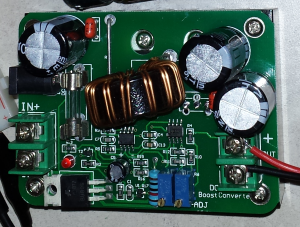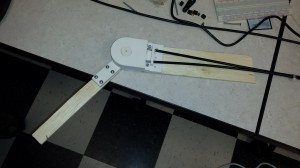Exoskeleton Arm Brace controlled by Automated (EMG) Mode and Joystick Mode In automated mode, the user’s bicep and tricep muscles control the direction of the exoskeleton arm brace. The benefit of this, is that the user will not have to rely on the joystick device to tell which direction the arm is moving. However, due …
Category: Mechanics
Includes all posts related to Mechanics
Apr 06
Updates to the site
Recent Updates to the Site: –Mechanics –User Interface –Circuit Design –Project Summary
Mar 27
Strength Test (3 Trials) with Updated Exoskeleton Design
The three strength test trials are shown below. Trial #1 Trial #2 Trial #3 This test was done using the 320Kg*cm servo motor. A variety of weights up to 8 pounds were used, where the outcome of the experiment was determined through the angle shown on the brace for each weight. Results Trial #1: 70 …
Mar 21
Adjustable Arm Brace, Force Sensing Resistor (100 pounds)
Through an auction on ebay, we placed a bid and won an adjustable metal arm brace that is used for rehabilitation purposes. To improve on our design, which was previously plastic, we have decided to use this arm brace to support the arm with the large amount of torque provided by the servo motor. The …
Mar 14
Strength Test, New Servo, Power Consumption
We performed a strength test with the 40Kg*cm servo with 55rpm shown below. After performing the strength test, the maximum amount of weight that the servo could handle at 26cm was 2 pounds. We realized that this servo was incapable of carrying an arm, therefore we decided to upgrade our servo motor. This was a …
Feb 26
Exoskeleton Arm controlled by sEMG signals and Joystick Device
In the video above, through 3D printed parts, we were able to construct an exoskeleton prototype that was successfully able to move through the sEMG signals located on the bicep and tricep. The servo used to control the prototype exoskeleton is shown in this link. The actual sEMG signals from the video are shown in …




Recent Comments